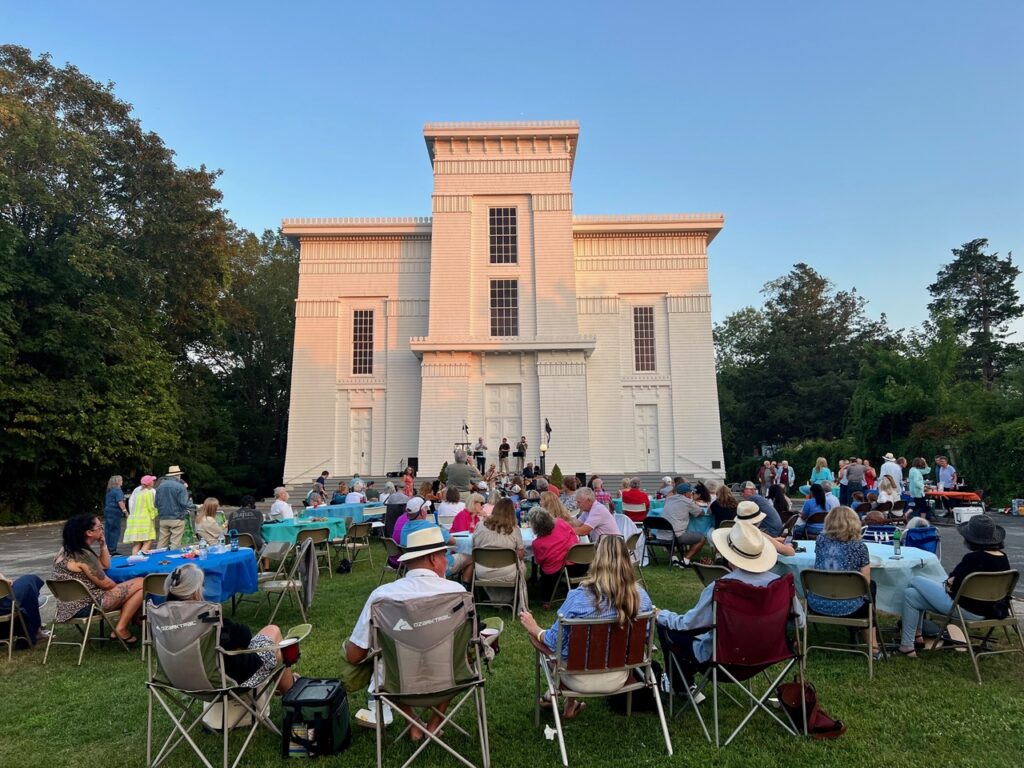The massive fire that tore through the old Sag Harbor Cinema in 2016 could have been the final curtain call for the history-soaked theater with the iconic, red neon sign heralding “SAG HARBOR” to Main Street below.
With the property already up for sale prior to the fire — a ferocious blaze that took 19 fire companies a multitude of hours to safely extinguish — developers were circling the vulnerable property. Then-owner Gerry Mallow was talking up a plan to transform the burnt husk of a theater into a new commercial retail space, one that would also swallow up the two flanking properties damaged in the inferno.
It did in fact take a village to fight the good fight, but the Cinema came out as the victor, swiftly returning to its rightful place in the heart of the Harbor’s downtown.


Left – Sag Harbor Cinema artistic director Giulia D’Agnolo Vallan sits with board member and proprietor of local art hub The Church April Gornik. Right – Executive director Genevieve Villaflor. (Photo credit: Doug Young)
Community to the rescue
Before the fire — which ignited in one of the neighboring buildings and, thanks to a windy seaside day, spread quickly to completely engulf the cinema — a plan was fermenting via the volunteer organization Sag Harbor Partnership to reimagine the theater as a nonprofit focused on film education, preservation and community gathering. But once the blaze ripped through 90 Main Street, the deal fell through.
For some well-connected residents of the famously protective village, the mere idea of meticulously curated Main Street without its signature Art Deco-style theater and sign – and a boilerplate structure in its place – was a nonstarter. It might have been past its prime, but the theater was an almost sacred part of the village’s charm-offensive aesthetic, a historic artifact that bridged generations while serving to welcome waves of East End newcomers.
Susan Mead, co-president of Sag Harbor Partnership and a land-use attorney who was instrumental in preserving the theater as a nonprofit, says community resistance to plans to develop the site amounted to an urban-planning exercise.
“In other words, those three buildings damaged in the fire could have been combined into a kind of interior mall,” she says. “It was permitted in the code and there were developers looking at it and we knew we had to act.”
Another key figure in spearheading the negotiations and fundraising effort to purchase and preserve the theater, artist and longtime Sag Harbor resident April Gornik recalls just how close the village came to losing its prized theater to developers.
“We had an estimated close date of December 28 and the fire was on December 16, so you can imagine our chagrin, not to mention the emotional cost to everyone in this village because it was so devastating to see it burn,” says Gornik, who’s on the board of Sag Harbor Partnership.



The cinema boasts three separate theaters for movie screenings, as well as a flexible use indoor work space, a cocktail bar and a private lounge. (Photo credit: Doug Young)
That sadness powered an unstoppable drive to save the town icon and, Gornik notes, it’s important to credit the many from all walks of Sag Harbor life who can take a bow.
“There was a network within the community of many generous small donors and many generous large donors. We had benefits, raffles, casino night, every kind of party that you could imagine,” she recalls. “We had a fundraiser in a bookstore, we got 35 cents from a child on Long Wharf. The fundraising effort to buy the theater and adapt it spanned every kind of donation, and we were grateful for everything.”
A tour de force among small theaters
While it’s only been a few years since the theater’s long-awaited 2021 reopening, it’s hard to remember the gap-toothed image of Sag Harbor’s Main Street without it — and almost impossible to imagine sans the restored sign that so symbolically captures the seaside enclave’s enchanting past.
“I think the fire ironically galvanized the community, because it was such a physical emptiness there… it was such a visual loss, it really helped to see the necessity to rebuild, and not just a building or commercial establishment, but a movie theater,” says Giulia D’Agnolo Vallan, a film writer and the cinema’s current artistic director who was among the early parties to show interest in purchasing the old Cinema.
“When we conceived this new adventure, my notion was, and also it reflects my experience as a programmer… to broaden what [former owner Gerry Mallow] was doing and make it more differentiated, bring in more popular films, classic films, experimental films… having three theaters now allows us to be very flexible and curious.”



Singer Billy Joel’s generosity earned him a popcorn stand. (Photo credit: Doug Young)
Reflecting Sag Harbor’s inner spirit as a muse for artists, writers and thinkers, the programming at the new Cinema spans classics like “Apocalypse Now” to sentimental favorites like “Mary Poppins” and “Stand by Me,” to documentaries like 1964’s “I Am Cuba,” co-produced by Cuba and the Soviet Union, and the National Geographic-produced “Sugarcane.”
You’re also just as likely to find a cult classic like “Shampoo” or “Paris, Texas” as you are a critical look at French New Wave classic “The 400 Blows” or a contemporary Hollywood vehicle like “Beetlejuice Beetlejuice” (or last summer’s dueling blockbusters “Barbie” and “Oppenheimer.”) And there is ample children’s programming, screening family-friendly classics like “Snow White,” “The Land Before Time” and “The Addams Family” that’s become a matinee ritual for so many local tribes.
“It’s very good when the audience becomes like a partner in what we’re doing. I’m not suggesting that everyone likes everything, but I see that people are becoming a little more adventurous,” says D’Agnolo Vallan. “It feels like the cinema has become a place of ideas, which I think cinema should provide, and a place of gathering and a place to expose our audiences to different processes of filmmaking and also filmmakers.”
Movies, and then some
Today, the Sag Harbor Cinema Arts Center sits in bright, airy contrast to its vintage, curtains-and-chandeliers iteration. Now a triplex with state-of-the-art audio and visual technology, its corridors are so crisp and clean you can practically eat your movie snacks off the floor. There’s a café, as well as a sleek rooftop cocktail bar called The Green Room, with spirits curated by local restaurateur Jesse Matsuoka, and a gallery for art and visual memorabilia connected to the movies.
Because of an easement purchased by the Town of Southampton at considerable cost, the not-for-profit theater offers discounts to Southampton Town residents, as well as space for community-based education, private screenings and film-and-art centered enrichment that goes well beyond a bucket of popcorn and a museum-quality collection of vintage movie posters.



The Green Room, the cinema’s popular upstairs cocktail lounge, also features and outdoor terrace. (Photo credit: Doug Young)
Recently, the theater celebrated actress Naomi Watts at its annual fundraiser, and often invites renowned actors and artists like Julie Andrews, Julian Schnabel and Isabella Rossellini to deliver talks on their work.
“I kind of always think in the sense of making it special for the audience and giving them the feeling when they come to us it’s going to a movie, and that it’s a big deal in a cool way,” says D’Agnolo Vallan. “To me it’s about how to keep it interesting.”
A shared local legacy, 2.0
While the word most commonly used to describe the pre-fire theater was “musty,” the old building itself was more than just a shabby home for arthouse and foreign films. It was a fuzzy throwback to the old days of Sag Harbor, when saloons well-outnumbered coffee shops, and the little village on the big waterfront proudly embraced its working-class heritage. It was also where many locals, like Wharf Shop employee Dede O’Connell, saw their first R-rated movie (for her, the 1969 Arthur Penn-directed “Alice’s Restaurant”).
While it was originally built in the 19th century for burlesque shows and vaudeville acts, the theater adapted to the times, transitioning as the nation did into silent films, then “talkies” and on into the Golden Era of Hollywood. In the late 1970s — by then long-adorned with the ‘30s-era sign — the theater was purchased by Mallow and turned into a one-screen movie house specializing in avant-garde cinema.
The legacy of the old theater is apparent in the new vision, but now, to everyone’s delight, there is thoughtful, ambitious screen-candy for every kind of moviegoer, from cinephile to casual fan.
Ellen Dioguardi, president of the local chamber of commerce, believes that, after what could have been the end of an era, the town not only regained its movie theater, but benefits from a cinema that checks all the boxes the village needed it to check.
“Sag Harbor is a village of resistance, and nobody wants to see it not be Sag Harbor. I’ve been here for 41 years, it’s changed tremendously, but I can always find the parts of Sag Harbor that I fell in love with, and one of them is the Sag Harbor Cinema,” she says. “And now I love it even more because it’s better.”





